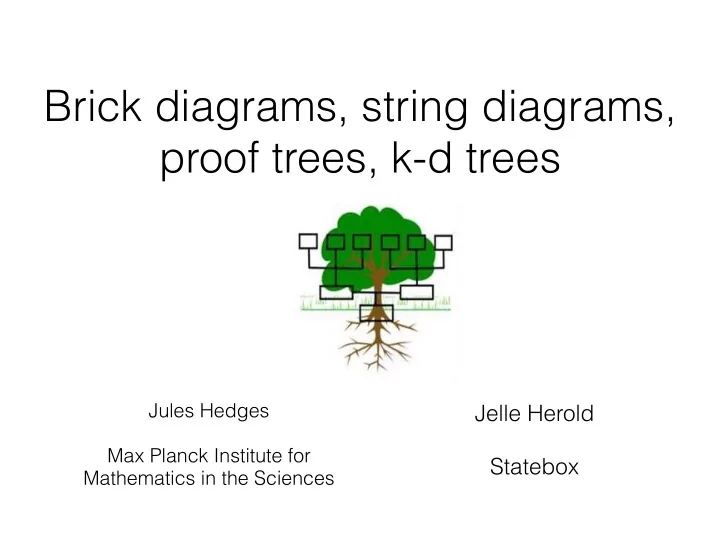

Brick diagrams, string diagrams, proof trees, k-d trees Jules Hedges Jelle Herold Max Planck Institute for Statebox Mathematics in the Sciences
We have plenty of stringy proof assistants Quantomatic Globular Opetopic
We need a stringy compiler String diagrams are still useful without a complete proof system… • programming • complex systems • DisCoCat • game theory • …
The obvious architecture Front end editor Rival front ends, naturally This talk Logical term language of monoidal categories (implemented in eg. JSON) Backend Backend Backend Backend
What is a string diagram, actually?
Follow the literature… … Joyal & Street (1991): It’s a “topological graph”
String diagrams as graphs • duh • Used by Quantomatic & pyZX • Graphs = CCCs, DAGs = SMCs
Planar graphs • We might care about non-symmetric category, e.g. linguistics • We might want to control where symmetries go, e.g. compiling for quantum computers • Planar graphs are annoyingly complicated
Rotation systems
Polygonal complexes
The Joyal-Street Theorem • String diagrams modulo isotopy are the morphisms in the free monoidal category on a signature • Equivalently: every interpretation induces an isotopy-invariant interpretation • Everybody knows this instinctively
Free categories a la Lambek • General principle: Morphisms in free categories are proof trees modulo commuting conversions • For monoidal categories: Noncommutative linear logic of tensor • So: we have an equivalence of categories between string diagrams (modulo isotopy) and proof trees (modulo commuting conversions)
k-d trees • A data structure from computational geometry • Special case of binary space partition trees • Closes the gap between topology and logic
k-d trees by example
k-d trees by example
k-d trees by example
A silly conjecture Higher category theory is just computational geometry • People study balancing operations on k-d trees for efficiency reasons • They ought to be the same as the defining data of a strict n-category
Globular pasting diagrams Strict monoidal category = 1-object 2-category (not suitable for serious work)
Cubical pasting diagrams Strict monoidal category = double category with 1 object and 1 horizontal 1-cell
Brick diagrams Take an extra Poincaré dual only of the vertical edges
Brick diagrams in SYCO
Tileorders
Conclusion The following are pretty much the same, more or less: • String diagrams with a choice of decomposition • Proof trees for the noncommutative linear logic of tensor • k-d trees of dimension 2 • Cubical pasting diagrams • Binarily composable tileorders
Demo time
Recommend
More recommend